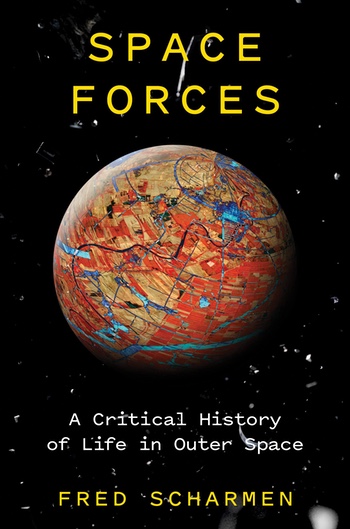Review: Space Forcesby Jeff Foust
|
| “Whether or not the dream of successful permanent life in space is eventually assured, it seems inevitable that people will continue to try and make that future happen,” he concludes. |
The visions of space colonies espoused by Gerard K. O’Neill a half-century ago, the start of a through line that extends to the ISDC space settlement sessions today, is one chapter of the book. Scharmen looks at other views of space settlement, such as in the fiction and non-fiction of Arthur C. Clarke and Wernher von Braun. He goes back even earlier, to writings by Konstantin Tsiolkovsky that was infused with the “cosmism” school of thought of the early 20th century that sought to optimize the universe for humanity, as well as J.D. Bernal, the British scientist who proposed space settlements in the 1920s.
The book’s final chapter looks at the present day and the two billionaires with their own different visions of space settlement: Jeff Bezos, who seeks to breathe new life into O’Neill’s vision of space settlements in free space; and Elon Musk, who continues to focus on settlements on Mars. Both visions motivate their employees and supporters, even if realizing them is still far in the future.
He offers an interesting comparison of the two: “Where Bezos takes apart whole industries and whole worlds, putting them back together in ways that suit his company’s needs—and sometimes with disruptive results in the world outside—Musk will simply make a version of the thing that is more efficient, more cost-effective, and cleaner—without requiring any massive change to lifestyles or the status quo.” While that may apply to other industries, it’s not clear it’s applicable to space. Bezos has, so far, done little to take apart the space industry, as Blue Origin moves as a glacial pace compared to Musk’s SpaceX. And while SpaceX’s Falcon 9 is, in some respects, a more cost-effective replacement to existing launch vehicles, that assessment overlooks the disruptive capabilities of rocket reusability, not to mention the industry-reshaping Starlink constellation and Starship vehicle.
Scharmen views all of these with a skeptical eye, unconvinced of their motivations, particularly those based on economic rationales: “If existing economic structures that maximize return on investment are extended into space, capitalism will need someone with desires and needs to exploit.” However, he doesn’t expect anything he writes to change that. “Whether or not the dream of successful permanent life in space is eventually assured, it seems inevitable that people will continue to try and make that future happen.”
There is not much organized opposition to space settlement. Scharmen mentions a 2019 conference in Seattle called the Salish Sea Anti-Space Symposium that the backers described as “a first of its kind event to say NO TO SPACE EXPLOITATION!” that he describes as an opportunity to critique not just Bezos and Musk “but the idea of space travel and space settlement altogether.” The event’s website, preserved since that 2019 event (first and only of its kind, perhaps), includes an illustration of a person stabbing an astronaut in the back of his helmet, air whooshing out, with the words “Don’t Let ’Em Leave”. Scharmen doesn’t mention this violent imagery or the topics discussed at event, including one speaker who gave a talk on “how A Conspiracy of Witches has been hidden in plain site, [sic] culminating in participation in the Apollo Mission, a sacred journey for practitioners of secret female technologies.” It’s hard to take such critics seriously, but perhaps movements get the critics they deserve.
This week’s ISDC won’t be just about space settlement and other long-term visions. There will be talks about nearer-term activities, including efforts to develop commercial space stations by the end of the decade to succeed the International Space Station—not exactly a O’Neillian settlement at L5, but something more realistic for the foreseeable future, if still challenging. Space advocates will continue to dream of crystal cities in space, but for now may have to settle for a studio apartment with a view.
Note: we are using a new commenting system, which may require you to create a new account.
